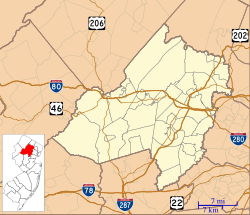
Morristown is a town and the county seat of Morris County, in the U.S. state of New Jersey. Morristown has been called "the military capital of the American Revolution" because of its strategic role in the war for independence from Great Britain. Today this history is visible in a variety of locations throughout the town that collectively make up Morristown National Historical Park.
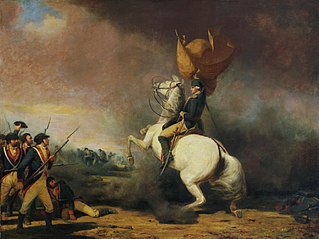
The Battle of Princeton was a battle of the American Revolutionary War, fought near Princeton, New Jersey on January 3, 1777, and ending in a small victory for the Colonials. General Lord Cornwallis had left 1,400 British troops under the command of Lieutenant Colonel Charles Mawhood in Princeton. Following a surprise attack at Trenton early in the morning of December 26, 1776, General George Washington of the Continental Army decided to attack the British in New Jersey before entering the winter quarters. On December 30, he crossed the Delaware River back into New Jersey. His troops followed on January 3, 1777. Washington advanced to Princeton by a back road, where he pushed back a smaller British force but had to retreat before Cornwallis arrived with reinforcements. The battles of Trenton and Princeton were a boost to the morale of the patriot cause, leading many recruits to join the Continental Army in the spring.
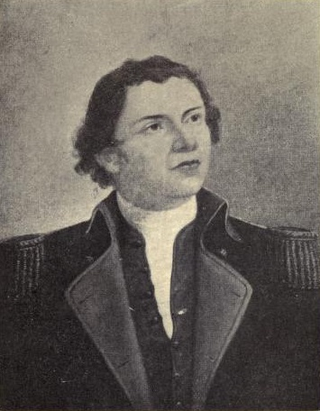
Hugh Mercer was a Scottish-born American military officer and physician who participated in the Seven Years' War and Revolutionary War. Born in Pitsligo, Scotland, he studied medicine in his home country and served with the Jacobite forces of Bonnie Prince Charlie, participating in the Battle of Culloden in 1746. With the failure of the Jacobite rising, Mercer escaped to Pennsylvania.

Morristown National Historical Park is a United States National Historical Park, headquartered in Morristown, New Jersey, consisting of four sites important during the American Revolutionary War: Jockey Hollow, the Ford Mansion, Fort Nonsense and the New Jersey Brigade Encampment site.
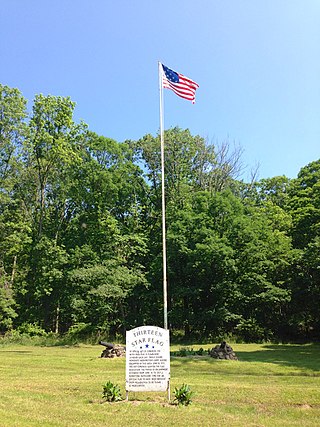
"Middlebrook encampment" may refer to one of two different seasonal stays of the Continental Army in central New Jersey near the Middlebrook in Bridgewater Township in Somerset County. They are usually differentiated by either the date of the encampment or their chronological order.

Fort Lee Historic Park is located atop a bluff of the Hudson Palisades overlooking Burdett's Landing, known as Mount Constitution, in Fort Lee, New Jersey, United States. Native Americans appear to have lived in the area for thousands of years before the arrival of Europeans. The bluff was the site of George Washington's 1776 encampment opposite Fort Washington at the northern end of Manhattan. Fort Lee is named for General Charles Lee. The site is a reconstruction of the encampment including the blockhouse, battery, quarters as well as a visitors center. It is part of Palisades Interstate Park.

New Jersey played a central role in the American Revolution both politically and militarily. It was the site of more than 90 military engagements, including the pivotal battles of Trenton, Princeton, and Monmouth. George Washington led his army across the state four times and encamped there during three hard winters, enduring some of the greatest's setbacks of the war as well as seminal victories. New Jersey's decisive role in the conflict earned it the title, "Crossroads of the American Revolution".
New Bridge was a prosperous mill hamlet, centered upon a bridge strategically placed at the narrows of the Hackensack River. In the American Revolution, New Bridge Landing was the site of a strategic bridge crossing the Hackensack River, where General George Washington led his troops in retreat from British forces November 20, 1776. Eleven engagements took place here throughout the war. The current Draw Bridge at New Bridge was installed in 1889 and added to the National Register of Historic Places on July 5, 1989. The area is now a New Jersey historic site in portions of New Milford, River Edge, Hackensack and Teaneck in Bergen County, New Jersey, United States.
The 2nd New Jersey Regiment was raised, on 9 October 1775, at Trenton, New Jersey, for service with the Continental Army under the command of Colonel William Maxwell. The regiment would see action at the Battle of Trois-Rivières, Battle of Valcour Island, Battle of Brandywine, Battle of Germantown, Battle of Crooked Billet, Battle of Monmouth, Sullivan Expedition, Battle of Springfield and the Battle of Yorktown. The regiment was furloughed, on 6 June 1783, at Newburgh, New York, and disbanded 3 November 1783.

Jockey Hollow is the name for an area in southern Morris County, New Jersey farmed in the 18th century by the Wick, Guerin and Kemble families. The origin of the name is still uncertain, but was used as such at the time of the American Revolution. For most of the Revolutionary War, it was used by portions of Continental Army as a winter camp site, and it housed the main Continental Army during the "Hard Winter" of 1779-80, believed to be the harshest winter in recorded history.

Pennsylvania was the site of many key events associated with the American Revolution and American Revolutionary War. The city of Philadelphia, then capital of the Thirteen Colonies and the largest city in the colonies, was a gathering place for the Founding Fathers who discussed, debated, developed, and ultimately implemented many of the acts, including signing the Declaration of Independence, that inspired and launched the revolution and the quest for independence from the British Empire.

The Ford Mansion, also known as Washington's Headquarters, is a classic 18th-century American home located at 30 Washington Place in Morristown, New Jersey. It was built by Jacob Ford Jr. in 1774 and is now owned by the National Park Service.

The Somerset Hills is known as the northern region of Somerset County located in the U.S. state of New Jersey and includes the municipalities of Bedminster, Bernardsville, Bernards Township, Far Hills, Peapack & Gladstone. The Morris County communities of the Chesters and the Mendhams are often considered part of the Somerset Hills.
Brandywine Battlefield Historic Site is a National Historical Landmark. The historic park is owned and operated by the Pennsylvania Historical and Museum Commission, on 52 acres (210,000 m2), near Chadds Ford, Delaware County, Pennsylvania in the United States. It is part of the site of the Battle of Brandywine fought on September 11, 1777, during the American Revolution. The Battle of Brandywine covered more than ten square miles, or 35,000 acres. However, the modern park only covers 50 acres which served primarily as the Continental encampment the two days prior to the battle. The battle was a decisive victory for the British and cleared a path directly to the rebel capital of Philadelphia. Brandywine Battlefield Park became a Pennsylvania State Park in 1949 and a National Historic Landmark in 1961.

Valley Forge functioned as the third of eight winter encampments for the Continental Army's main body, commanded by General George Washington, during the American Revolutionary War. In September 1777, Congress fled Philadelphia to escape the British capture of the city. After failing to retake Philadelphia, Washington led his 12,000-man army into winter quarters at Valley Forge, located approximately 18 miles (29 km) northwest of Philadelphia. They remained there for six months, from December 19, 1777 to June 19, 1778. At Valley Forge, the Continentals struggled to manage a disastrous supply crisis while retraining and reorganizing their units. About 1,700 to 2,000 soldiers died from disease, possibly exacerbated by malnutrition.

Fort Billingsport, at Billingsport in Paulsboro, Gloucester County, New Jersey, United States, was an American Revolutionary War fort on the Delaware River. The site of the fort is now a public park of the same name, located at the Plains Terminal at the Port of Paulsboro between two oil refineries.

Morristown Green, most commonly referred to as the Green, is a historical park located in the center of Morristown, New Jersey. It has an area of two and a half acres and has in the past served as a military base, a militia training ground, and an area for public executions. It is now a public park in which many community events are held. It was added to the National Register of Historic Places, listed as a contributing property of the Morristown District, on October 30, 1973.
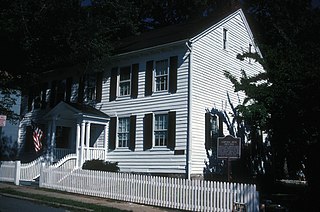
The Dr. Jabez Campfield House, also known as the Schuyler Hamilton House, is a historic, two-story, braced timber-frame colonial Georgian-style house and museum located at 5 Olyphant Place, Morristown, New Jersey.
Dr. Jabez Campfield was a colonial-era doctor, one of the earliest to set up practice in Morristown, New Jersey. He served as a surgeon in the Continental Army during the American Revolutionary War. During the Continental Army's winter encampment in Morristown in 1777, Dr. Campfield helped inoculate soldiers against a smallpox outbreak that spread through the army and the area that winter. Dr. Campfield was a surgeon on the Sullivan Expedition in upstate New York in the summer and autumn of 1779, during which he kept a detailed diary which has been preserved and published. During the winter encampment of 1779-1780, surgeon general Dr. John Cochran stayed in Dr. Campfield's home, and his home served as a "flying hospital". Dr. Cochran's niece, Elizabeth Schuyler, came to stay in Dr. Campfield's home, and while there fell in love and became engaged to Founding Father Alexander Hamilton.
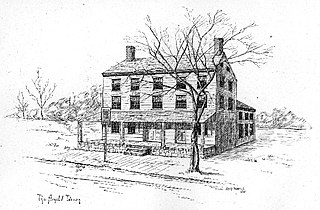
Jacob Arnold's Tavern, also known as the OldArnold Tavern and the Duncan House, was a "famous" historic tavern established by Samuel Arnold circa 1740. Until 1886, it was located in Morristown Green in Morristown, New Jersey. In 1777 it served as George Washington's headquarters during the Revolutionary War, and it was the site of Benedict Arnold's first trial in 1780. The National Park Service claims "Much of [Morris]town's social, political, and business life was conducted at Arnold's Tavern" during the Revolutionary era.

